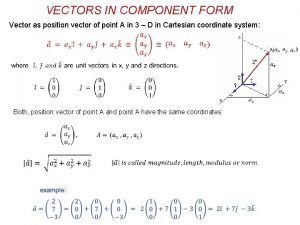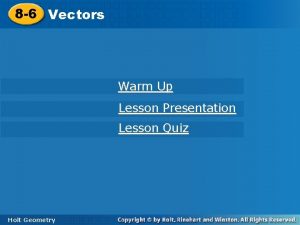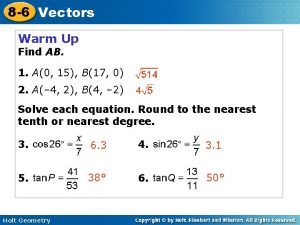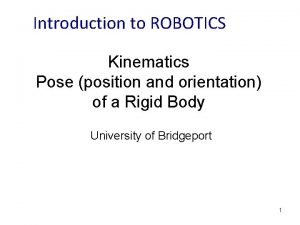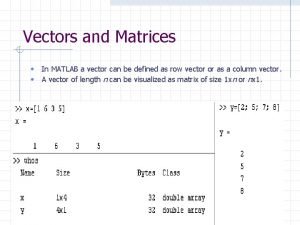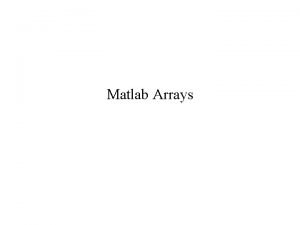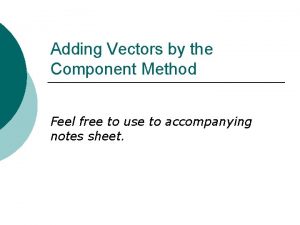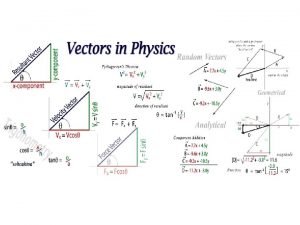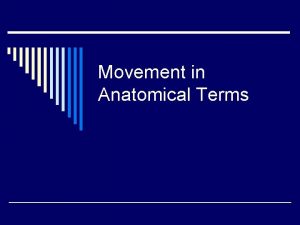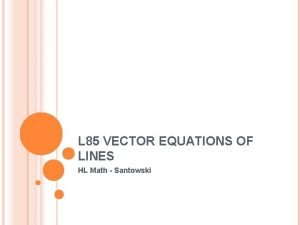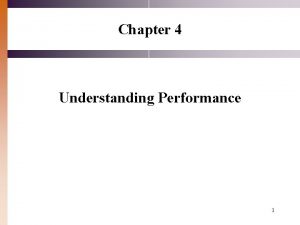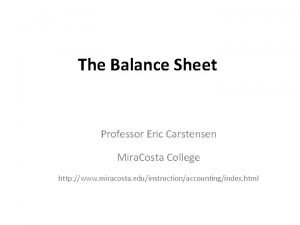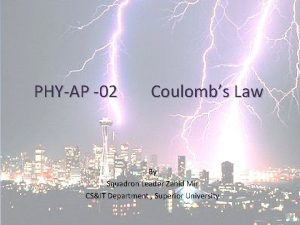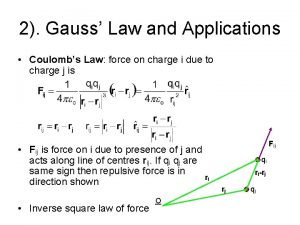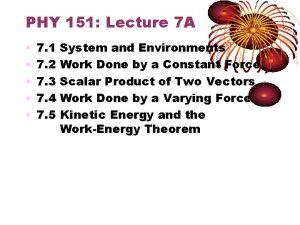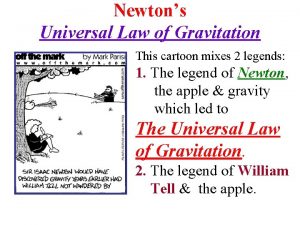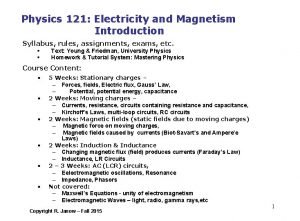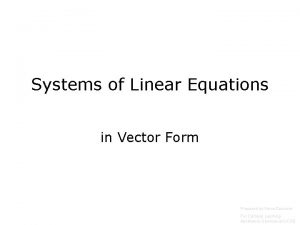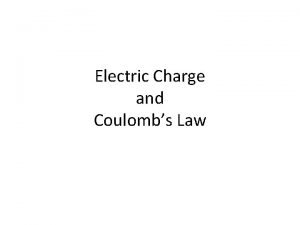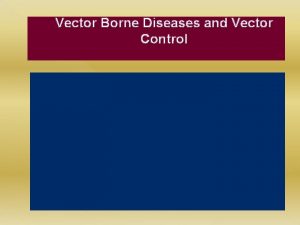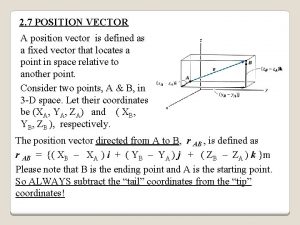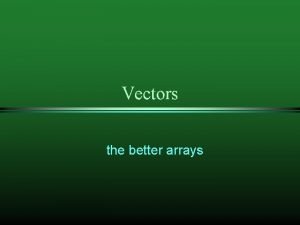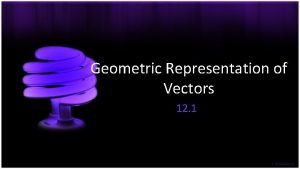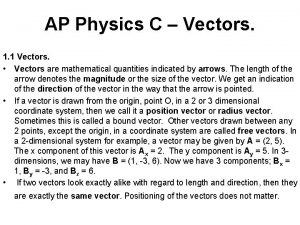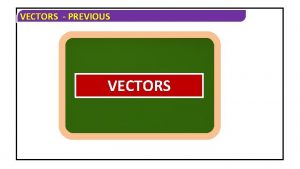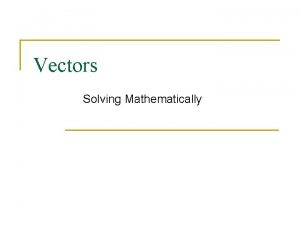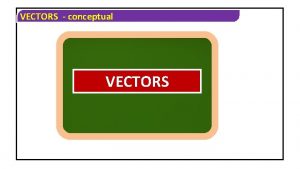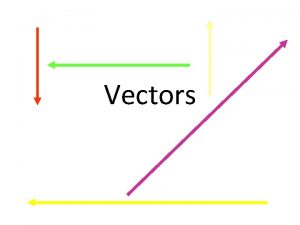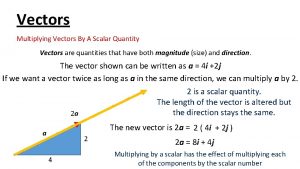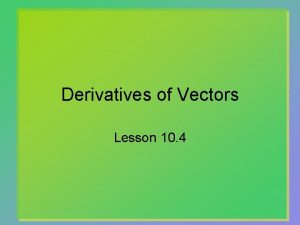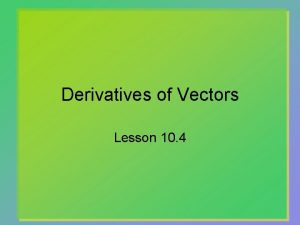VECTORS IN COMPONENT FORM Vector as position vector
































- Slides: 32

VECTORS IN COMPONENT FORM Vector as position vector of point A in 3 – D in Cartesian coordinate system: Both, position vector of point A and point A have the same coordinates:

VECTOR BETWEEN TWO POINTS

Unit vector Definition A unit vector is a vector whose length is 1. It gives direction only!

PARALLEL and COLLINEAR VECTORS

ARE 3 POINTS COLLINEAR ? How can you check it: 1. Form two vectors with these three points. They will definitely have one common point. 2. Check if these two vectors are parallel. Show that P(0, 2, 4), Q(10, 0, 0) and R(5, 1, 2) are collinear.

THE DIVISION OF A LINE SEGMENT A = (2, 7, 8) B = ( 2, 3, 12) INTERNAL DIVISION P divides [AB] internally in ratio 1: 3. Find P point P is (2, 6, 9) EXTERNAL DIVISION X divide [AB] externally in ratio 2: 1, or X divide [AB] in ratio – 2: 1. Find Q point Q is (2, – 1, 16)

DOT/SCALAR PRODUCT Definition θ or: Product of the length of one of them and projection of the other one on the first one

In Cartesian coordinates:

Properties of dot product

CROSS / VECTOR PRODUCT Definition

In Cartesian coordinates: Using properties of determinates We can write cross product in simple form:

Properties of vector/cross product



How do we use dot and cross product • To find angle between vectors the easiest way is to use dot product, not vector product. • Angle between vectors can be acute or obtuse • Angle between lines is by definition acute angle between them, so Dot product of perpendicular vectors is zero. • To show that two lines are perpendicular use the dot product with line direction vectors. • To show that two planes are perpendicular use the dot product on their normal vectors.

Volume of a parallelepiped = scalar triple product TEST FOR FOUR COPLANAR POINTS

Are the points A(1, 2, -4), B(3, 2, 0), C(2, 5, 1) and D(5, -3, -1) coplanar?

A line is completely determined by a fixed point and its direction. Using vectors gives us a very neat way of writing down an equation which gives the position vector of any point P on a given straight line. This method works equally well in two or three dimensions.

LINE EQUATION IN 2 – D and 3 – D COORDINATE SYSTEM ● Vector equation of a line ● Cartesian equation of a line

Find the equation of the line passing through the points A(3, 5, 2) and B(2, -4, 5). Find the direction of the line: One possible direction vector is The Cartesian equation of this line is (using the coordinates f point A). The equivalent vector equation is

ANGLE BETWEEN TWO LINES Two vectors

Shortest distance from a point to a line

Relationship between lines 2 – D: 3 – D: ● the lines are coplanar (they lie in the same plane). They could be: ▪ intersecting ▪ parallel ▪ coincident ● the lines are not coplanar and are therefore skew (neither parallel nor intersecting)



Distance between two skew lines (sometimes I see it, sometimes I don’t)

PLANE EQUATION A plane is completely determined by two intersecting lines, what can be translated into a fixed point A and two nonparallel direction vectors ● Normal/Scalar product form of vector equation of a plane ● Cartesian equation of a plane


What does the equation 3 x + 4 y = 12 give in 2 and 3 dimensions? https: //www. osc-ib. com/ib-videos/default. asp http: //www. globaljaya. net/secondary/IB/Subjects%20 Report/May%202012%20 s ubject%20 report/Maths%20 HL%20 subject%20 report%202012%20 TZ 1. pdf

Find the equation of the plane passing through the three points P 1(1, -1, 4), P 2(2, 7, -1), and P 3(5, 0, -1). Find the equation of the plane with normal vector containing point (-2, 3, 4). vector form: Find the distance of the plane from the origin, and the unit vector perpendicular to the plane.

ANGLES ● The angle between a line and a plane ● The angle between two planes is the same as the angle between their 2 normal vectors take acute angle

● INTERSECTION OF TWO or MORE PLANES
 Component form of a vector
Component form of a vector What is mean by position vector
What is mean by position vector Russian ballet terms
Russian ballet terms Component form of a vector
Component form of a vector Write vector in component form
Write vector in component form Component form of a vector formula
Component form of a vector formula Position vector formula
Position vector formula Matlab vector of vectors
Matlab vector of vectors Matlab initialize vector
Matlab initialize vector Component method of vector
Component method of vector Vector direction
Vector direction Vector components
Vector components Vectors form 3
Vectors form 3 Fundamental position vs anatomical position
Fundamental position vs anatomical position How many fundamental starting position
How many fundamental starting position Cartesian form
Cartesian form Present continuous interrogative
Present continuous interrogative Directed line segment definition
Directed line segment definition Ay cosa
Ay cosa Resolution of vectors
Resolution of vectors Personality-related position requirements form
Personality-related position requirements form Personality-related position requirements form
Personality-related position requirements form Report form statement of financial position
Report form statement of financial position Eric carstensen
Eric carstensen Accounting statement of financial position
Accounting statement of financial position Coulomb's law in vector form
Coulomb's law in vector form Vector form of gauss law
Vector form of gauss law Hooke's law vector form
Hooke's law vector form Gravitational constant
Gravitational constant Normal force and gravitational force
Normal force and gravitational force 2qqqq product
2qqqq product Forms of linear equations
Forms of linear equations Coulombs law
Coulombs law
